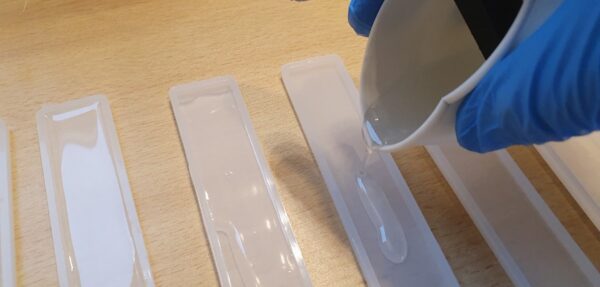Ensuring the safe disposal of unwanted epoxy is crucial. Luckily if you adhere to our guidelines getting rid of Entropy Resins® can be straightforward.
We once received feedback from a customer who attempted to dispose of uncured epoxy by flushing it down the toilet. However, the epoxy didn’t flush away as expected and instead fixed to the bottom of the bowl, where it cured underwater. The customer then tried to remove it with a chisel, but this approach was unsuccessful and resulted in the toilet bowl breaking!
Epoxy is indeed a robust material…
The process of safely disposing of epoxy actually starts during your project. It’s important to consider the following three questions:
-
Determining the Required Quantity of Resin
While it may seem self-evident, avoiding excess epoxy is simpler than dealing with surplus. Therefore, the initial step in the appropriate disposal of your epoxy involves accurately estimating the quantity required for your project prior to commencement. Subsequently, it is advisable to prepare our resin and hardener in the modest quantities to prevent wastage. This approach not only ensure efficient utilisation but also promotes environmental responsibility.
-
Is it Worthwhile Saving any Spillage?
Oops! Spilled some resin? No worries. If you happen to spill some or if there’s a leak, try to scoop it up – you might be able to use it later. But remember, if you’re using a solvent to clean up the mess, make sure to check the guidelines first. And here’s a big no-no: never let resins, hardeners or any waste contaminated with solvents find their way into aquatic environments, drains or even on the ground.
-
Is Disposal of Epoxy Always Necessary?
Have you concluded your project and find yourself with leftover epoxy? You might be inclined to dispose of it hastily, but it’s worth taking a moment to reconsider. Both unused resin and hardener boast an impressive shelf-life.
If a substantial amount remains in the container, it could be beneficial to retain it for prospective projects. Having a supply on hand is always advantageous and contributes to waste reduction. So, before you decide to get rid of it, consider whether you might need it down the line.

Safe Disposal of Epoxy Resin
- Get the Mix Right: First things first, make sure your epoxy is mixed correctly. It’s like baking a cake – getting the ingredients right is half the battle won. When the resin and hardener are combined at the right ratio, the cured epoxy isn’t hazardous. So, that’s a win!
- Empty and Cure: Got some unwanted epoxy left? Make sure its fully cured before you think of disposing of it. And if you’re looking to get rid of used epoxy container, try to empty it as much as possible – ideally, it should contain no more than 3% of the total capacity.
- Time to Say Goodbye: Once you’ve nailed the previous bullet points, you’re all set. The cured epoxy and containers can now be disposed of in your regular waste.
Remember, when it comes to materials like epoxy resin, safety first! Always follow these steps to ensure a safe and environmentally friendly disposal process. It’s professional, and it’s the right thing to do.
Advice for Emptying a Container
If you’re looking to empty a container before you discard it, here’s a pro tip – warmth is your friend. Containers tend to give up on their contents more readily when they’re warm. So, find a snug spot in your workshop, leave the can to heat up for a while, and you might find the draining process goes smoothly. But, lets not forget safety. Even though these products have low toxicity, curing epoxy can emit hazardous fumes and produce enough heat to set nearby combustibles alight. So, always proceed with caution. It‘s all about balancing efficiency with safety…



One response to “Guidelines for Safe Epoxy Disposal”
Posted by Santhosh G
Thanks for the valuable tips for disposal of epoxy and necessity of disposing the epoxy resins.
Posted on April 9, 2024 at 7:13 am